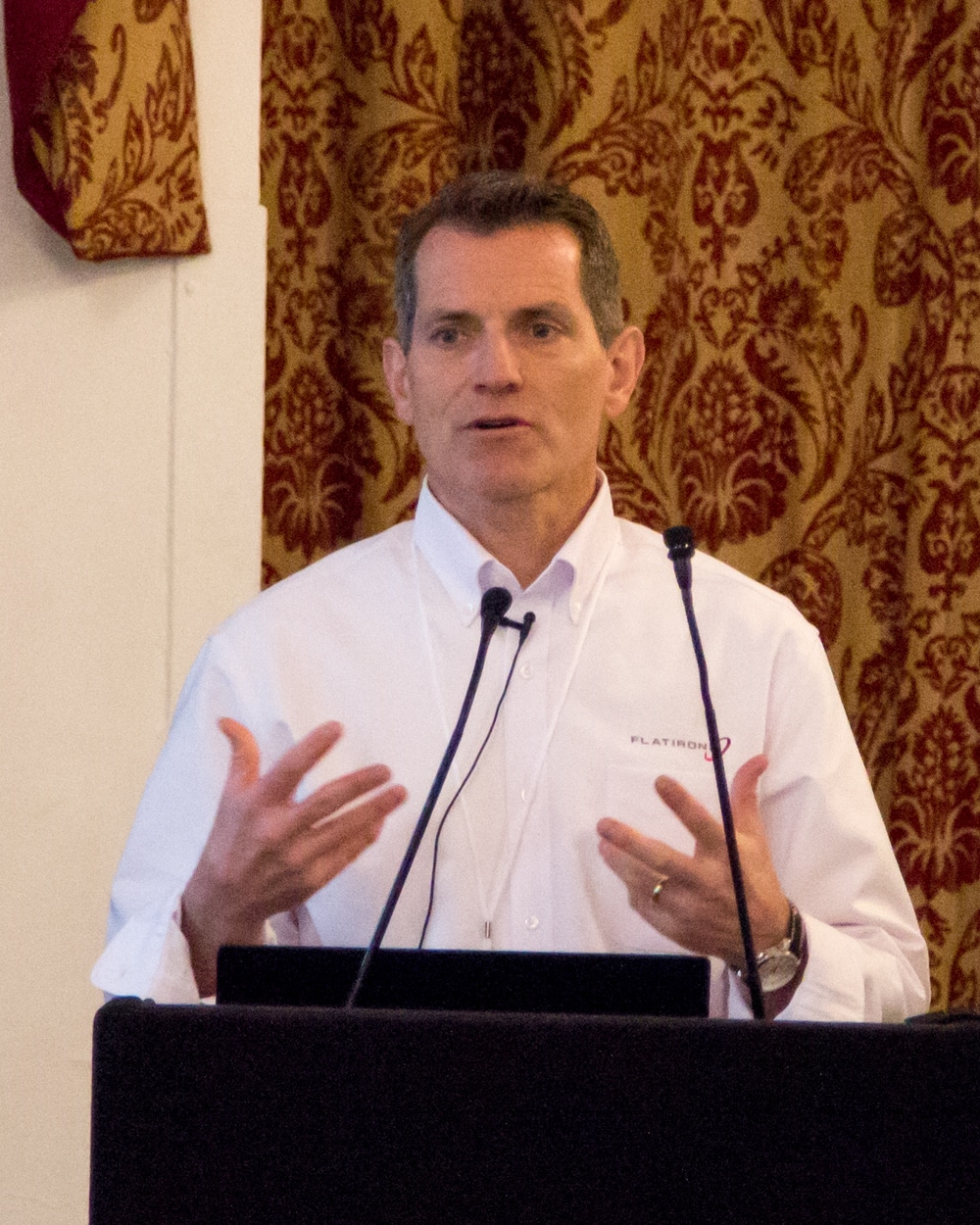In this presentation from the 2018 Typefi User Conference, Chris Kaefer, Director of Consulting at Flatirons Jouve, discusses what you need to consider when looking for a Content Management System and, ultimately, how to choose and implement a CMS.
What do Abraham Lincoln and a tree have to do with it? You’ll have to watch to find out!
Transcript
CHRIS KAEFER: CMS, Abraham Lincoln, and a tree, and before I get there, this morning I was sitting in and I saw Caleb’s slide deck and he had a little intro and a picture of himself, I’m like, “Crap, I gotta do that too.”
And it just made me wonder, though, why do speakers who have this slide put their picture on the slide, it’s like we’re here live, maybe that way everybody knows we’re not stealing somebody else’s slide deck, I don’t know.
Anyways, as Chris said, background…
I started with Pearson Education almost 20 years ago and I was telling someone at the back of the room, it was a very interesting start back in the SGML days, if some of you remember that, and at Pearson I was involved with a custom publishing solution called ESource.
Way before its time, we developed, based it on FrameMaker and OmniMark code, and it was for the first year and second year professor who was putting together custom books for their introductory courses.
Really cool solution, nobody bought it. Kinda sucked and failed, but it was sort of the beginning of things that we were doing at Pearson around digital and content management and content to the user.
My years at McGraw-Hill Education in New York City were a little different. I was involved in digital asset management solutions, content management solutions, I drove Chandi crazy for a little while towards the end of my tenure there with Typefi on an application called Create.
Create, again, is a custom publishing solution that McGraw-Hill has, and we were trying to see how to incorporate Typefi into that process, and they probably called me all kinds of names because of the stuff that I gave them. But we can talk about that over drinks at some point.
And so fast forward to the last eight years I spent with what was Flatirons Solutions, now Flatirons Jouve, probably soon to be Flatirons Solutions again, little identity crisis going on there.
But I said to somebody, one of the most interesting things of those last 20 years is being on both sides of the table, literally. As the publisher, as the customer, and really understanding what we need to do to get the content out. And now, on the consultancy side, with a completely different set of lenses.
And it really helped provide, just, context. Every time I walk into a customer now, knowing, really, how they feel and what the pressures are, and vice versa.
Who is this Abe guy and what is the deal with the axe?
So, getting to my title. CMS, Abe Lincoln, and a tree, where’d that come from?
Over the years I’ve loved to just capture quotes that encourage me, that invigorate me, and help me in my professional development. And I came across this one from Abe, and it says, “Give me six hours to chop down a tree and I’ll spend the first hours sharpening the axe.”
I said, “Hmm.” As I was prepping for this I said, “That’s what this whole thing is all about, isn’t it?”
As we’re looking for, even how to create a template for Typefi, or as we’re doing something much bigger in our organisation, looking for something to manage our content, or even in life, if we don’t plan, we tend to miss our mark.
And so I wanted to use that, but then later on, after I gave Shanna the title, I’m like, “Ah, crap man, I used Abe Lincoln. Do people even know who Abe Lincoln is here?”
But, interestingly enough, we were walking around London, and I inserted a picture, I don’t know how much you can see this, but there’s actually an Abe Lincoln memorial in London.

Does anybody know where that is? Yes.
AUDIENCE MEMBER: Embankment Gardens.
CHRIS: And just- Oh!
See? First session after lunch, gotta keep you guys on your toes. This is like, when I saw where you put me Chris, thanks much, right after lunch, everybody’s comatose, they’re not listening anyways. So I’ve tried to come up with a way to keep you guys on your toes.
So yeah, Abe Lincoln is actually in London, and there’s a little history to it, it’s a fun little read, it’s about three lines why he’s even there. He was a replacement for another statue, and so, look it up, it’s kind of funny.
But the other interesting thing here is, the quote is actually wrong. If I had done the homework, which I did after I put it on the slide, I said, “Let me really check if Abe actually said this.” He didn’t.
So the Abe Lincoln historians sort of laugh at the quotes that are attributed to Abe. He’s never said this.
And there’s all kinds of pictures and drawings, well not pictures, but drawings of him with an axe. He grew up out on a farm, there is some history about him doing a lot of log splitting, but there is zero history of him actually saying this.
So, again, moral of the story is: Do the research. And that’s what the next half hour is all about. I’m not going to tell you, “Here are the three best CMSs,” or, “You fill in the first letter that’s best for you, WMS or DAM or whatever it is.” I’m not going to tell you that.
What I want to do is help stimulate, if you are thinking about implementing something to manage your content, I want to help stimulate that thought, “How do I get there?” And I’m not going to say “without failure” because we know we’re not perfect and when we fail we try and try again.
But, you know, what have we learned at Flatirons, what have I learned over the last 10, 20 years to reduce risk and help me potentially hit my target better?
About Flatirons Jouve
Next three slides, again, marketing got involved, they said, “Chris you gotta talk about this.” So this’ll just go quick quick quick.
Flatirons Solutions, global company, revenue a little north of 170 million Euro—I did the conversion from dollars for you guys. Well I guess it should have been pounds, sorry.
2500 employees, plus or minus, depending on what day it is. We have 800 plus clients and we’re actually in 14 countries where we have offices, but again, we’ll work with anyone.
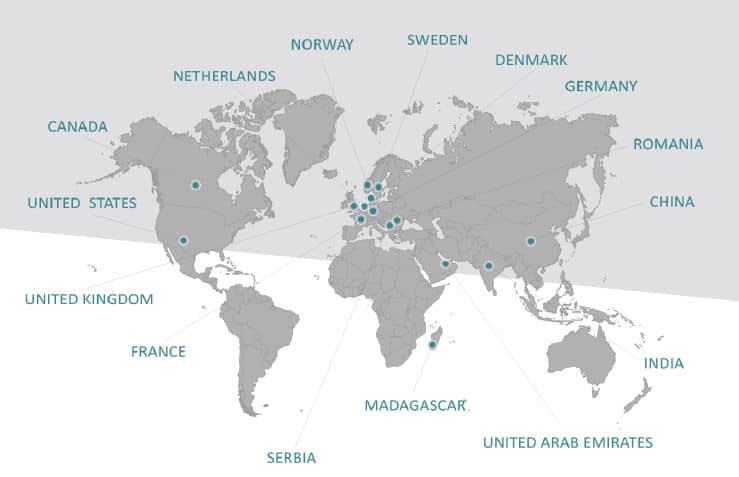
What do we do? Well, we started out as a consulting organisation, really focusing on enterprise content management about 15 years ago, cut our teeth on this thing called Documentum, it’s still around, it’s still being used. But that’s where our work really started, about 15 years ago.
Over the years, we’ve branched out and now we work in many verticals, from banking to government agencies to the airline industry and aircraft manufacturers, education and others.
The airline industry’s kind of a really cool thing, and I really like what we were able to do there. For any of you who’s flown, I’m sure all of you have, you see the pilot walks in with that big black briefcase kind of thing, and typically it’s stuffed full of papers.
We were able to develop a solution which we call “the flight bag”, which essentially allows a pilot to enter what aircraft he has, what the customisation is, and if you know anything about aircraft, each plane is really unique, right? Even though it’s a 737 or a 767, from the way the seats are arranged, what’s in the back of the seats, the aeronautics, everything is unique based on tail number.
And so the pilot can just type in the tail number, it uploads all the documents into his tablet, and he no longer has to, well I guess he still carries his big black bag, because that’s what they do, but it doesn’t have 10 pounds of paper in it anymore.
So it’s a real cool application, it’s a custom solution that we built at Flatirons so, I’m just kind of throwing that out there.
Our marketing guys also want to say, “Hey, we’re inventing the future today!” Kind of a cool tagline. Whatever, right?
But we’re really focused, as I’m saying, going forward in the aviation and publishing industry, helping customers manage content. And really, that’s a huge, huge thing.
What is content anyway?
Which brings me to my next slide, but before I go there—because it’s cheating a little, me showing the next slide—if you were to define content, in the context of what we’re talking about, how would you define “content”? Nobody ever thought of that, content definition? A word document, an image?
And the man back there. Oh ho! Look at that. Nice, getting better.
Yep. So I found this little study by AIIM, and they, I think, sent out 100,000 surveys, and typically nobody answers them, but I think they probably got like 1000 returns, so, not a great number.
Anyways, part of the question in the survey was, “How do you describe content?”
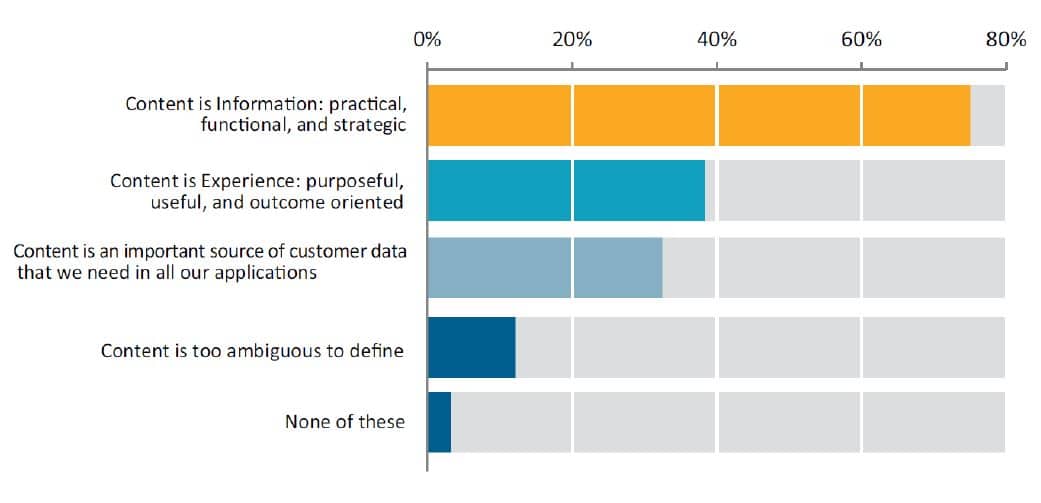
And almost 80% of the respondents said, “Content is information, it’s something practical, functional, and strategic.” Cool.
The second, sort of, bucketed group said, “Content is experience, purposeful, useful, and outcome oriented.” Great.
And then another group said, “Content is an important source of customer data that we need in all our applications.”
And then the last two I kind of found interesting. “Content is too ambiguous to define.” Which oftentimes, it is. What is that stuff? We can’t put our hands on it, but yet, we know we need to manage it.
We all have our own way of managing our files, whether it’s in a MacOS, or—thanks Mr Gates—in a Microsoft OS. How we create folders and structures and how we name them and when you go to somebody else’s machine or somewhere else, you’re like, “I can’t find anything,” because people organise things differently.
Content Management Systems
So having a content management system sort of forces you into certain guard-rails, and helps you really think about content, forces you to define it, and then manage it.
I kind of did a little Googling there too, and said, “Well, what does the World Wide Web tell us about content management systems?” And a CMS is a software application or set of related programs that are used to create and manage digital content. Awesome.
Well, then this guy, Michael Woodbridge, comes along last year from Gartner and says, “Content management is dead, kaput, nada, finita, right? We’re not doing that stuff anymore.”
I’m just like, “Oh my goodness, Flatirons Solutions and everybody else who does CMS, what are we going to do? Content management is dead!”
He said, “It’s all about content services, it’s content service applications, platforms and components that we put together with these things, maybe they’re called APIs, which nobody can define anyway, but it’s a solution for everything, because as long as we have open APIs, the world is a much better place, right?”
And everybody uses those buzzwords. But yet, last week I did this little search, and if you’ve ever used Google Trends, you can type in anything, you see how things are trending.
It’s sort of a relative interesting number, it doesn’t give you how many hits, but there’s this line that you see up here, it’s 100 and everything is relative based on that.
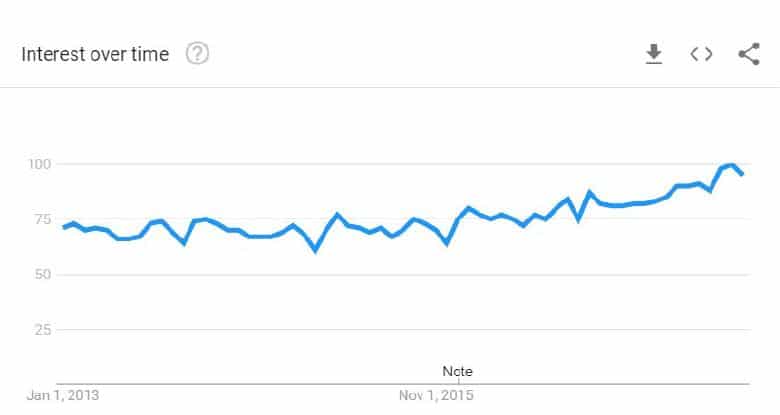
I said, “Well, that’s a very interesting line, right?” Since I just did from 2013 forward, there tends to be either flat or kind of going up, and 2017 is probably somewhere here, and yet we had the greatest number of searches for content management probably in the last few months.
So, to me again, it says, regardless of what people say or what they call it, we still need to manage our content, right? But it’s such a broad spectrum.
These guys, I don’t know if you’ve ever heard of them, Real Story Group, great guys, do an incredible amount of research, and if you are in the market of looking for a content management solution, they have some great stuff.
And, for me, this is sort of an underscore that content management is not dead. Whether you’re looking at Capterra, which is again, a website you can use to compare different applications, they list over 400 CMSs. 98% most of us have never heard of, but they’re still there, right?
And they’re relatively new, they’re not built in 1990, they’re built in 2015, and they’re available.
Wikipedia—all right, you can debate its accuracy or validity, but it has over 200 solutions listed on their Wikipedia page. Again, I counted them that are 2015 or newer, or have released a latest version since 2015 or newer.
And again, this Real Story Group, the reason I put that up there, it’s a really cool slide, and they called it a subway map, and they break it down by different groupings, whether it’s web content, digital asset management, enterprise, marketing content, enterprise, ECM again, or CRM.
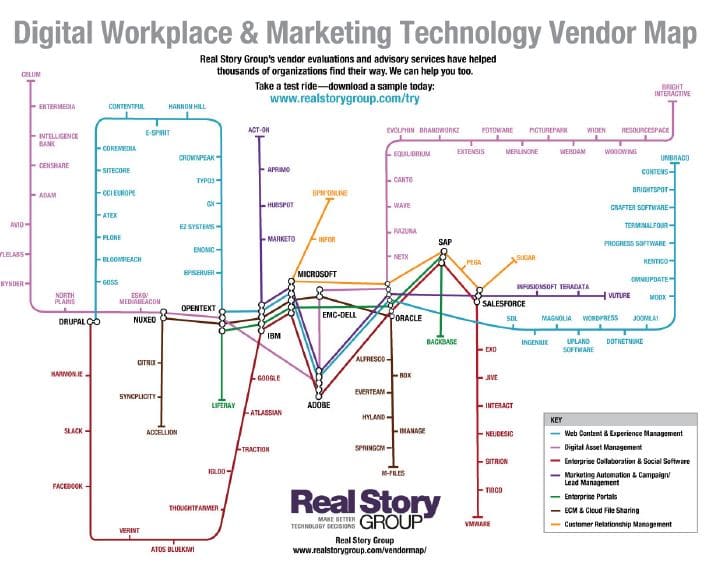
But the whole point of this slide is that, as we’re moving forward with all these solutions, there are intersections, right? And we’re finding that, as we evolve these solutions, they become either very specific or very broad.
And so it’s just, I put all this out there again, if you’re thinking about going down this road, what you need to consider. Because, at the end of the day, a CMS solution manages lots of stuff.
Who in the room here today employs, or has a CMS solution, and file systems don’t count. Nobody. This is going to be a hard one.
All right. So for all those who didn’t get one, don’t worry, you’re only in second place, so if you ever watch Talladega Nights, I won’t tell you what that means. Check it out.
But, on the back room we have more little swag, I don’t want to take it home, it weighs, you know, I fly here. So please, help yourself.
But the point is, kind of getting back to the slide, we are managing stuff. And it’s important to manage that, and what I want to talk about in the next two slides is really what a CMS won’t do and what it will do.
What a CMS will not do
A CMS, it will not create better content. So, if you’re going into this thinking, “I’m going to implement a CMS and create better content,” stop.
At the end of the day, it’s the authors, the editors, the proofreaders, the designers, and those in the content life-cycle who create better content.
But what a CMS will do, it’ll make sure that from start to finish, we know who’s working on what. We will make sure that when somebody goes and gets a document, they’re not looking at five files and going, “Oh my goodness, they named the file wrong, I don’t know what the latest one is.”
Part of the value add of a CMS is this simple thing called “versioning”, meaning the last one is always available. Talking a little bit more about that on the next slide.
CMS will not give you instant gratification. So again, if you think, “This is going to solve all of my problems, or it’ll solve it today,” it won’t do that.
I’m working on a project right now, and for two weeks it took the team to set up several environments, dev, QA, and production, and it includes this workflow engine called Activity Services by Alfresco, and then another CMS, their content services, there are load-balancing…
You know, it’s a whole architecture for the solution, and it took them two weeks, right? And the customer’s going, “It took you two weeks to do that?”
There is no big easy button when you’re going down the CMS road. There is no, “Oh, I click the install, like I’m putting an app on my phone, and I watch a little progress bar and there it is.”
And that’s an important thing to remember. These are not simple solutions. And I don’t mean to say that to scare you, but really to help set expectations. This is not a trivial process, you will not get instant gratification, it will take time, it will require you thinking through process and governance.
And let’s be honest, it will not solve all your problems. A CMS will not solve the problem that we heard this morning, being able to embed an EPS in a Word document. Sorry, it just doesn’t do that. You guys need to figure out how to solve that yourself.
There is also no one CMS that will solve all your content management needs. There just isn’t. We can customise it to the nth degree, and get you there, but we’ll talk about what you really want to think about as you go down the road of CMSs.
Bottom line is, with the right planning—remember Abe, right? He spent his first few hours, well, somebody said he did, sharpening the axe before he cut down the tree. With the right planning, then selecting the CMS will help solve most of your problems.
What a CMS can do
So, what can it do? It can manage user rights and access to content.
I don’t know if you have a problem with that, but at Flatirons and especially in our subsids, Six Red Marbles and Jouve, they’re always struggling. We don’t want all these people accessing our content.
We do work for many publishers, and we want to make sure that Pearson gets access to Pearson material, McGraw-Hill to McGraw-Hill content. We want to make sure that Course Hero gets access to Course Hero content.
And we also want to make sure that not everybody can delete files, because that’s a problem. I hear these stories all the time: “Oh my goodness, we just deleted our last folder where all our IP, our work in progress stuff is.” And now what? They’re stuck, right?
So a CMS will, if you implement it properly, will prevent that from happening.
It can also manage how content is described, and again, this morning there’s a question about adding a language tag into a Word document so that the paragraph can be processed properly based on the language.
A CMS inherently has this thing called a “metadata model”, and it’s really describing the content, and it’s incredibly useful if done well. Not only from a search and discovery, but from a processing perspective. So CMSs are all about that stuff.
And it can manage how content is saved, processed, and stored. And what I mean by that, again, the whole notion of versioning and rollback, we don’t just have one version of a document, we have 16 or n number of versions.
But any decent CMS will allow you to roll back if you realised you really want version four to be the last one.
It’s little things like that that are really hard to do on regular file systems. I have not been able to figure that out yet in Microsoft, in Windows.
You can easily incorporate processing pipelines. I mean, think Typefi from a processing pipeline, sort of not really, but kind of, right? And it can all become part of that, it can be scripted in, we use xprop pipelines all the time in some of the XML processing that we do, and it can just be built into CMSs.
So, it really adds value, it’s not just a content management system, it allows the building in of all kinds of additional workflows and processes.
You can institute backup and retention policies. We often walk into customers and ask them, “Do you have a backup policy?”
“Uhhh, yeah.”
You ask them to show it and they can’t. Or retention policies.
“Do you save your work all the time, for eternity? Why?”
And people look at you, “Well, because we have to, or we want to.”
These are all the things that you can just automate within a CMS, you can move the stuff off to cheap storage, and so on.
And some will actually have workflow solutions in there. Again, nothing like we saw this morning in the Typefi features, but workflows from a business process engine perspective that will actually allow people to receive tasks to review and approve. So CMSs will actually do that.
Again, I don’t know everybody’s experience and knowledge around CMS so I’m trying to be very broad on this, and just get you to think about—because again, most hands were down—encourage you to think about how maybe a CMS will help you.
And you don’t have to buy one that’s $500,000 or even a million dollars, there are lesser cost CMSs out there too.
So, how much time do I have? I don’t even know, 2 o’clock? Okay, so 15 minutes. Keep rolling here, still got a few slides.
The path to implementing a CMS
So, path to implementing a CMS. And this is somewhat sequential and most of the next few slides, I have about three or four slides, are based on the methodology that we use at Flatirons, we developed it over 15 years ago, and it’s evolved over the years. And we have used it on almost every implementation that we’ve done.
Again, not every one was successful, probably part of the reason was Flatirons failed, part of the reason is the customer failed, but this is the process that we take and I’m just going to walk you through real quick.
You can take notes, I don’t know if we’re going to share the deck later, I can certainly do that. But this is how we approach getting to CMS.
We talk to the users and the customer about their business objectives.
“Why are you doing this? And again, is it because you’re on an old version of Windows? Mmmm, then I’m going to spend a little time with you and really drill you, what’s the business driver behind going to a CMS?”
And I can tell you, without a business driver, these projects fail. Just to do it because the old one is no longer working is not the reason to do it, right? Maybe rephrase that narrative a little bit, but find a business driver behind it.
Know what you’re willing to spend in terms of time and dollars. Again, we walk into customers, it’s like, “Is it a bread box, is it a garage, is it something?” You have to know what you’re willing to go into, because that will help drive the decision making.
Worst scenario is, you’re like, “Okay, we sort of know, kind of, not.”
And we spend several weeks on this process, we make a recommendation, say, “This is the CMS that will solve your problems.” And you look at the price tag and you go, “We can’t afford that.” Now you’ve just wasted four weeks.
So knowing what you can spend both from a resources and dollars perspective is really important.
In the room together, agree on what your constraints are, what your assumptions are. Is a constraint that you have to work within some security requirement? Is a constraint that you have to be able to move files around in a very short period of time?
Talk those through. Every project has assumptions and constraints, and they have to be articulated.
Understand the needs of the user. This is a great one, right?
Many times we get brought into companies and we’ll sit in the room with the IT group, and if anybody’s in IT, this is not a knock on you whatsoever, you guys are awesome, you are the backbone of the organisation, without you we don’t work, because when my computer goes, who do I go to? Helpdesk IT.
But, at the end of the day, you do not, typically, understand the process of the organisation, or the needs of the end user. And so it is really, really, really, I can’t underscore that enough, important to understand the needs of the user.
That doesn’t mean you have to have a personal interview with every one of them, but you have to know how they work, because if you don’t, you will fail.
You have to know what content you want to manage. The question before, describing content, everybody was like, “I’m not really sure,” right?
You have to know what you’re working with. Is it a video file that’s 50GB? Is it XML that’s five kilobytes? Or anything in between. That will drive, ultimately, the selection of the solution that you end up taking.
Outline the current development process, and again, I have a slide on that so I’m not going to talk about that too much at the moment.
Express user requirements in natural language. Again, I don’t want to blame IT, but oftentimes we’ll get an Excel spreadsheet, and I’m looking at Chris because we worked with them on a project a couple of weeks ago, and it’s like this long.
And you’re reading this stuff and it’s like, “I have no idea what this requirement even means.”
I’ll give you an example on a later slide of how we typically put user requirements together. Which just helps people understand what’s going on.
Consider administration and maintenance. Do you have an IT organisation, do you not? Is it pulling someone whose day job is being an editor and saying, “Hey, you’re going to administer this new system!”
Don’t do that, right? They have a day job, they’re focused on something. Really figure out who’s going to administer and manage the system.
And review security needs. As I mentioned, at Flatirons we work in many industries. Banking, highly regulated. Government, highly regulated.
It’s a little different when you go, even to a publisher who does a trade magazine, right? Yes, I know, they have images which are one of a kind, but it’s not government documentation, it’s not banking and credit card information.
The level of security is very different, so that has to be a component that you think about.
The Flatirons Jouve approach
So, our approach. We start off, and we call this thing SourceOnce, doesn’t really matter, that’s what we called it for whatever reason.
And way back then, a Solution Blueprint seemed to be the right description. Over the years we’ve had these battles internally. Do we call them blueprint, is it really a blueprint, is that sort of old school? Doesn’t matter.
But anyways, we have a section called the Business Success Framework, and when I first started, my mentor who’s left the company since, really drilled into me how important it is, when you meet with a customer, to understand their business objectives.
And he said, “Chris, structure these as a set of strategic objectives, each supported by a set of tactical objectives.” Which kind of makes sense, right? But it’s about strategy of the solution and how you’re going to meet that strategic objective.
And then he said—and this is the one that always gets me and I love throwing this out, it makes people go ‘oh, yeah, okay now I get it’—he said, “These are topline goals that make or break the organisation and the exec stakeholders. Think of them as things that would get someone, an executive sponsor, fired or promoted.”
And once you put it this way, then people are going, “Oh my goodness, people can lose their job if we don’t do this, or attain this?” But you can also be promoted.
But the reason we do this, is it really helps people focus on why we are doing this. Hugely, hugely important.
If you cannot articulate why you’re asking the owner of your company to give you here, whatever it is, 50,000, 500,000, whatever price tag you came up with, to do something, you got a problem, right? You cannot go to your owner or management and ask for dollars if you can’t tell them what the return on the investment is.
The second section that we focus on is the Solution Definition, which is all about describing what the goal of this thing is. And it’s not technical in any nature, this is stuff that I focus on, I’m not technical in any stretch.
We have really, really smart people back in Boulder and other offices who we really don’t let out, because they’re really smart and they code incredibly well, they’re super geeks. They’re the ones who do the next section, which is the architecture work and the developmental work, but we still do the definition, which is kind of English.
And this is where we spend time doing two things with our customers. We walk through the current process and the to-be process. And they’ll say to us oftentimes, “Chris, why do you want to walk through the current process? That’s the piece that’s broken.”
Or, “That needs the enhancement, or the solution is going to fit into the current process. And we know what we’re doing, why do we want to regurgitate that?”
And so often we find that when the customer’s telling us this, they keep coming back going, “Oh no, we’re also doing this. Oh no, we’re also doing this.”
Or we’ll ask very pointed questions, “Why is task 15 here?”
And they’ll look at us and go, “Um, ’cause we’ve always done it that way.”
And so, even with a CMS, this is an important aspect just to go through that workflow, that process. Because a CMS ultimately ties into all these steps in the process.
And it allows you, because now you’re doing this project, and it allows you to work with a team and go, “Are these tasks really valued, do they add any value at all, or is this a hold-over from 10 years ago when we did things completely different, when there was different management and, you know, it’s still there?”
So, I encourage you to take time to do that. And then you can get to the to-be process.
The other part is this thing called User Stories. We’ve been using Agile Development for 10 plus years, and we use User Stories for all the work that we do, and it is a very simple statement that basically says, “As a, fill in a role, as a desktop designer, I want to, some action, I want to annotate an image in the browser so that I don’t have to pull it in and out of a file system.”
But the requirement is clear now, right? You have defined who’s doing it, what they’re doing, and why they want to do it.
And even there, the last thing the value, hugely important. Because again, we’ll work with customers that say, “Hey, you know, as a writer I want to do this.”
It’s like, “Okay, why?”
Put a value behind it, because that makes it valuable to the process, valuable to the company.
So, just stuff to think about as you’re going down the CMS road.
And then the Definition is the general approach that we take to defining what the CMS is. If it’s ready at that point, you can think about what the vendor and product recommendations are.
But also include, or have somebody develop, a content architecture, a functional architecture, and physical architecture. And even those can be done without necessarily knowing the solution.
Whether it is—again I’ll throw some big CMSs out there that we work with a lot—whether it’s an Alfresco CMS, or any other of the big ones out there. These things can be done not necessarily having selected technology, and it’ll help you once you get to technology selection much better.
And then, finally, we always think about how this is going to be implemented, right? Think about weeks, months, and be able to present that.
So a little sidebar real quick, and I know I only have five minutes left here, around the content strategy and content architecture, why is this so important, right? And I think on the previous slide I had this, a good content architecture helps ensure that your content vision will become a reality.
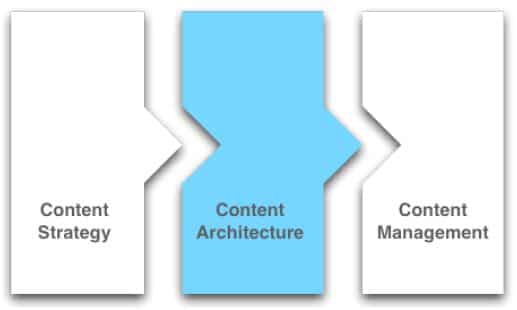
And part of, I think, what drives managing content is you really should think about what your content vision is. Is it just create and throw away, is it create and reuse? What’s that strategy with your content? And that’ll help develop this content architecture also.
And what is an architecture? At the end of the day, it’s the overall view of how your content is not only organised, but the metadata that’s associated with everything, who has access to it, and the states. Is it a work in progress, is it R1, is it R2, is it archived?
These are all things that become part of your content architecture. And whether it’s a simple CMS, or a very complex one, it’s something that you need to spend time working on.
Finally, this is one that oftentimes gets forgotten or pushed to the side because nobody has time for this, is change management. And I’m sure every one of you has gone through change of some kind, whether it is in your personal life, or in business.
Change is difficult, right? Because we’re creatures of habit, we get to know how we do things, and we become efficient at it. If you decide to go down the road of implementing a CMS, please, please, please think about change management.
And I’m not going to go through every item here, because we’re running a bit short.
Have a communication strategy, and let people know what’s coming, have a training plan, put it together early, have a deployment plan.
Make people feel like they’re part of the process, because the last thing, I know I don’t like it, when you’re working, working, working, all of a sudden, they come, “Here, here’s this new thing, use it, we think it’s the best thing since sliced bread.”
You’re going, “Why did nobody ask me, why did nobody tell me, this thing sucks!”
And so having a change management plan before you go to deployment will not necessarily guarantee success, but I can tell you it will make implementation and rollout so much easier.
We do have this thing called, and I just have a slide up here, we do this readiness assessment typically.
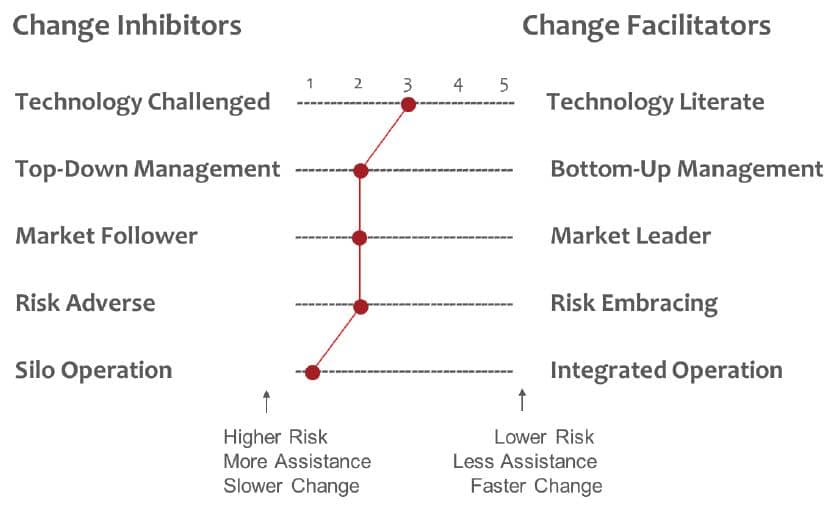
It can be something very simple, it can be something much more complex, but typically there are inhibitors to change, and facilitators to change, and we do this oftentimes with bigger organisations because we want to know, we want to get a sense of what you’re up against.
Do we have a department that are all technically challenged and risk averse? Well then you approach it very differently than if you have a very techno-literate and risk-embracing organisation. Because, again, it’ll help you to plan the rollout, and just an example of it there.
2 o’clock, am I getting, I’ve still got a few slides.
What’s that, start again? We started late? Okay.
Examples of CMS implementations
I kind of flew through the CMS slides there. I have a couple, I don’t want to call them case studies, but just two or three examples of very different approaches to CMS-like implementations that we’ve done over the years. I can go through them very quick and then still have a few minutes for Q&A if Chris lets me do that. Thumbs up, okay.
So, just real quick I have three different projects, one in education, one in medical, and one journal publishing.
Note: A text version of these case studies is reproduced at the end of this transcript.
Education (McGraw-Hill)
This was one that we did for McGraw-Hill, and at the end of the day we implemented Alfresco as the CMS solution.
But the 30 second build up to that—we arrived at their Seattle offices in October, they needed something deployed in January, so it was super hyper-speed design and development.
But we were able to do it because they knew exactly what they wanted. Not necessarily from a technology perspective; they knew what they needed from a business perspective, and what they needed to do from a process perspective.
They were essentially building learning objects in a habitat solution, Inkling Habitat, some of you may have heard of it, I don’t think I’m declaring any secrets here.
And they were then going to manage those learning objects and build courses and then deploy on the web. So they needed a way to manage all these LOs.
And they already knew they wanted to use AWS and all the Amazon infrastructure, and so we were able to do that in, really, two months. Not to get to a fully functional system, but what we call a minimal viable product.
But, again, the only reason we were able to do that is because the customer had done the legwork that they needed when we came into the office there.
Medical (WebMD)
From a medical perspective, this one was for WebMD. Again, they had, their business driver was huge. At the end of the day, they were looking to make it easier for doctors and the medical profession to contribute content to the WebMD site.
I don’t know if it gets used a lot here in Europe but certainly in the US it’s sort of the go-to site both for the medical profession and for just individuals like myself if I have a pain somewhere and I’ll Google, “Hey, my hip hurts,” or, “I feel sort of a pain,” and you get all these results and input from doctors and so on.
So, they came to us and said, “Hey, we have this need, we have a portal that’s already out there, we need for you to provide us with a form-based authoring platform so that doctors and individuals can contribute to that.”
So again, in both of these cases, McGraw-Hill and WebMD, there was already a clear definition on what the business driver and needs were. And at the end of the day, in this case, I think this was a, is this MarkLogic? This was an Alfresco-based CMS.
Journal Publishing (ASTM International)
And then the last one, really quick, is ASTM. ASTM was looking for a content management solution to manage some of their standard components, and they knew they were going to do the authoring in XML.
And so, over a period of time, we went in, we worked with the team, we really went through that SourceOnce process that I just laid out to you, in like 15, 20 minutes, with business objectives, definition, and the architecture, and we were able to come to the point where we said to them, “For your needs, MarkLogic is actually the best solution,” and we were able to implement it.
But again, the reason I chose those three, is because they came to us with a good amount of information already and being able to articulate the why and the what, and then we provided the how.
Questions
CHANDI PERERA: I’ve got a question, Chris. When you’re defining the to-be process, there’s a tendency to be conservative and way too open and say, “Yeah, give me everything,” when you’re looking for, like, a screwdriver you ask for the whole tool chest. How do you control that, or how would you manage that?
CHRIS: Yeah, so the to-be is a little bit of give and take, right? Because at the end of the day, the customer knows the current process. And we have the luxury of coming in with almost a naive approach and can ask those questions that nobody has asked, simply because they’ve been part of the process.
We will actually go through and ask about every task in the process of why you’re doing it and what’s the value. And it allows us to drop things out, or actually add things based on what the customer’s needs are, and that allows us to get to the to-be process.
It’s again, not a trivial amount of work, it’s hard work, and it’s, I want to say, even soul-searching work, because, again, a lot of the current processes have been around forever and a day.
And to look someone in the eye and say, “Why are you doing that?” or even challenging, “Is there value to what you’re doing?” is not easy because now they’re almost taking it personally, they’re like, “Oh my goodness, what I’m doing has no value?”
No, that’s not what I’m trying to say! Is that task, can we eliminate that task and free up time for you so now you can do two or four hours more on something else?
And that’s sort of the workshop, we literally do a workshop around current process and to-be process.
CMS Examples
The text of these case studies has been reproduced from the Powerpoint presentation.
Education Publishing (McGraw-Hill)
McGraw-Hill Education provides customised educational content, software, and services for pre-K through post-graduate education.
Project
Build out internet-scale content management and deployment infrastructure to support client’s next-generation Digital Learning Ecosystem.
Business Challenge
- Today’s curriculum building applications are designed for a specific domain within the K12 MHE businesses and require significant institutional and local knowledge in order to create a course structure and populate it with appropriate and approved learning objects.
- Client required technical expertise to build and deploy a system to support its educational publishing requirements.
Solution
- Provided architectural guidance, back-end design, and implementation for a content repository and publishing microservice.
- Set up Amazon AWS architecture using hosted PaaS products.
- Initial implementation supports K-12 education and provides access to:
- Compound Learning Objects authored in Habitat Inkling;
- Classroom management and evaluation software based on Engrade;
- Integration with Microsoft Mix and other content delivery mechanisms.
Results
Client’s curriculum designers and authors now have an easy-to-use environment to efficiently create, manage, and publish curriculum in a highly available and scalable fashion.
Medical Publishing (WebMD)
WebMD is a leader in delivering high value, highly accessible information on medical conditions, health management, and healthy living for tens of millions of users worldwide.
Project
Leverage and update existing infrastructure to create a next generation platform for content capture, approval, and distribution to millions of users.
Business Challenge
- Make it easy for doctors and other medical professionals to contribute content that can be used by other medical practitioners or the generic public to improve their understanding of health issues.
- Reduce the cost of content capture, processing, and monetisation.
- Support multi-channel publishing optimised for web and mobile formats using channel-neutral XML.
Solution
- Solution that allows more efficient capture of crowd-sourced content that is core to WebMD’s successful business model.
- Full content lifecycle solution that includes:
- Forms-based authoring to allow physician contributors to author content in an intuitive and user-friendly manner;
- Conversion of captured content to XML;
- Automated workflow for editorial and medical review of captured articles/content;
- Multi-channel publication of approved content to Professional Portal used by medical practitioners and Consumer Portal used by patients.
- Built custom solution atop existing WebMD IT assets, including Documentum platform that was upgraded as part of this implementation.
Results
Reduced barriers to capturing new, timely, accurate content of interest to WebMD users for improved content monetisation.
Journal Publishing (ASTM International)
Publishing journals requires complex, multi-level workflows to manage the production of individual assets (figures, etc.), articles, issues, and collections with internal and third-party providers.
Project
Provide a multi-channel publishing capability for a leading publisher of print and electronic journals and articles for a leading standards organisation.
Business Challenge
- Server the subscribers of publications spanning dozens of standards bodies with timely, compelling content.
- Deliver publications to multiple channels simultaneously.
- Seamlessly blend new and existing material, as well as internally authored and externally authored content on-demand to meet the topical requirements for a new issue.
Solution
- Provide a flexible journals publishing solution leveraging the best of breed third party technologies, including:
- Xopus for browser based authoring of compliant XML content;
- MarkLogic XML database for management of reusable component content and assembly of new XML-based publications.
- Increased velocity and flexibility in publishing to websites, mobile, and print issues for ASTM journals, articles, and other publication types.
Results
ASTM’s editors now have efficient tools for bringing new publications to market, while content contributors have the tools to create XML without the need for technical training.

Chris Kaefer
Director of Consulting | Flatirons Jouve
Chris has more than 20 years’ experience in publishing solution design and delivery, including content and metadata modelling. He led the development of content management and custom publishing solutions on behalf of two of the largest educational publishing firms. He also spearheaded the XML strategy and digital transformation of numerous clients to meet the evolving needs of students, instructors, and learning designers.
As Director of Consulting at Flatirons Jouve, he leads a team of seasoned consultants, technical leads and developers who deliver solutions across the globe for organisations in education, aerospace, heavy industry, and financial services markets. He has been a featured speaker at the MarkLogic user conference, and a member of industry groups such as American Association of Publishers, IMS Global Learning Consortium and the Book Industry Study Group.

